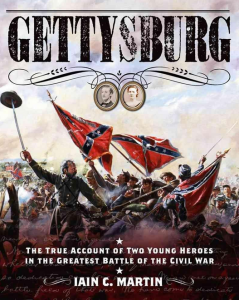Gettysburg for Young Readers
 I am quite certain that one or more Civil War aficionados with a leaning toward bibliophilia has catalogued the number of books dedicated to the Battle of Gettysburg. The number must reach into the tens of thousands: general histories, books that focus on command, strategy, and tactics, books that single out particular days of the three-day battle, books that emphasize specific details, or that follow the campaign with particular regiments or even individuals. And the number of books, articles, essays, even movies about Gettysburg seems to inexorably grow.
I wonder...how many of these books are accessible to young readers? Having spent a good deal of time engaging many of these sources, my guess is not that many. The cynics among us might ask why we bother reaching out to kids with the written word. Young people engaged with the Internet and its trappings: seconds-long sound bytes, rapid fire information, and the easy access of social media posts are certainly appealing to kids who are plugged in to the outside world at all times. I do not disapprove. Social media and the Internet has been the greatest advancement in education since the printing press...at least in my estimation.
I am quite certain that one or more Civil War aficionados with a leaning toward bibliophilia has catalogued the number of books dedicated to the Battle of Gettysburg. The number must reach into the tens of thousands: general histories, books that focus on command, strategy, and tactics, books that single out particular days of the three-day battle, books that emphasize specific details, or that follow the campaign with particular regiments or even individuals. And the number of books, articles, essays, even movies about Gettysburg seems to inexorably grow.
I wonder...how many of these books are accessible to young readers? Having spent a good deal of time engaging many of these sources, my guess is not that many. The cynics among us might ask why we bother reaching out to kids with the written word. Young people engaged with the Internet and its trappings: seconds-long sound bytes, rapid fire information, and the easy access of social media posts are certainly appealing to kids who are plugged in to the outside world at all times. I do not disapprove. Social media and the Internet has been the greatest advancement in education since the printing press...at least in my estimation.
But does that mean we should give up on the idea of young readers picking up a history book and engaging its contents? I think not. Success will come with striking a balance. Visual imagery, relevance, and an exciting narrative style is essential when the goal is to inspire a kid to read history. They can take what they learn and go interactive - turning to social media armed with information and an inquisitive spirit.
I am acquainted via Twitter with the author Iain Cameron Martin, who has put together what I think is an ideal introduction to the Battle of Gettysburg for young readers - Gettysburg: The True Account of Two Young Heroes in the Greatest battle of the Civil War. His easily accessible narrative style, accompanied by beautiful illustrations and contemporary images and accounts of the battle's participants, follows the campaign from June, 1863 into Southern Pennsylvania for a detailed investigation of the battlefield drama as it played out between July 1-3. He explores the battle's aftermath and legacy and what's more, interjects the first-hand testimony of two young residents of Gettysburg who witnessed the battle: Tillie Pierce and Daniel Skelly.
Martin writes out of the shadow of modern controversy. Rather, he takes an even-handed approach to the battle narrative - simply telling the story of two armies struggling for their respective causes and what was at stake. But at the same time, he makes clear the issues forming the foundation of those causes.
When I visit Gettysburg, as I do frequently enough, I am always struck by the number of young people exploring the rock formations in Devil's Den, climbing Little Round Top in search of the spot of Chamberlain's famous charge, or recreating Pickett's doomed assault on Cemetery Ridge. I am sure these kids would benefit greatly form Martin's work. We might quibble with his details or analysis. But any well-conceived history should make us think - and Gettysburg certainly succeeds at that.
With compliments,
Keith